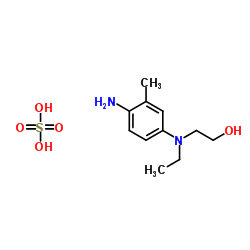4-(N-Ethyl-N-2-hydroxyethyl)-2-methylphenylenediamine sulfate

4-(N-Ethyl-N-2-hydroxyethyl)-2-methylphenylenediamine sulfate structure
|
Common Name | 4-(N-Ethyl-N-2-hydroxyethyl)-2-methylphenylenediamine sulfate | ||
|---|---|---|---|---|
| CAS Number | 25646-77-9 | Molecular Weight | 292.352 | |
| Density | 1.1g/cm3 | Boiling Point | 364.3ºC at 760mmHg | |
| Molecular Formula | C11H20N2O5S | Melting Point | 155 °C | |
| MSDS | Chinese USA | Flash Point | N/A | |
| Symbol |



GHS06, GHS08, GHS09 |
Signal Word | Danger | |
|
Contact allergy to colour developing agents in the guinea pig.
Contact Dermatitis 19(4) , 290-5, (1988) Colour developing agents, derivatives of p-phenylenediamine, can cause contact allergy. Patch test reactions to more than one colour developer are sometimes seen in patients. To study whether this is due to simultaneous sensitization or cross-reactivity, guin... |
|
|
Contact dermatitis to CD4.
Contact Dermatitis 12(1) , 48, (1985)
|
|
|
Contact allergy to colour developing agents. Analysis of test preparations, bulk chemicals and tank solutions by high-performance liquid chromatography.
Derm. Beruf Umwelt. 37(2) , 47-52, (1989) Colour developing agents which are derivatives of p-phenylenediamine can cause contact allergy. This study was done to perform if the observed simultaneous test reactions between different colour developing agents could be explained by common contaminants, re... |
|
|
[CD-4 burns associated with acute poisoning].
Zhonghua Zheng Xing Shao Shang Wai Ke Za Zhi 6(1) , 40-1, 76-7, (1990) Eleven patients burned, with CD-4-a colon darlopel were cured in our hospital from July 1978 to March 1986. Five of them were combined with acute poisoning. CD-4 is a poisonous, corrosive and irritant compound of ammonic benzene. It can be absorbed through sk... |
|
|
Allergic contact dermatitis from color film developers: clinical and histologic features.
J. Am. Acad. Dermatol. 28(5 Pt 2) , 827-30, (1993) We evaluated two patients with allergic contact dermatitis that resulted from exposure to color film developers. A lichenoid eruption developed in one patient, whereas an eruption more characteristic of an acute spongiotic dermatitis developed in the second p... |
|
|
Cross sensitivity in colour developers.
Contact Dermatitis 10(5) , 280-5, (1984) Colour developers are widely used and contact dermatitis and lichen planus-like eruptions from them are well-known. As a result of automation, there have been few recent reports of contact dermatitis from colour developers. We describe here 4 cases of dermato... |
|
|
A capillary electrophoresis chip for the analysis of print and film photographic developing agents in commercial processing solutions using indirect fluorescence detection.
Electrophoresis 22(2) , 348-54, (2001) The separation and detection of both print and film developing agents (CD-3 and CD-4) in photographic processing solutions using chip-based capillary electrophoresis is presented. For simultaneous detection of both analytes under identical experimental condit... |
|
|
Allergic contact dermatitis from colour developers used in automated photographic processing.
Contact Dermatitis 40(2) , 109, (1999)
|
|
|
Allergic contact dermatitis from colour developers: absence of cross-sensitivity to para-amino compounds.
Contact Dermatitis 30(5) , 301, (1994)
|
|
|
[Lichenoid contact eczema caused by color film developer].
Hautarzt 42(4) , 251-3, (1991) We report on a single case of a lichen planus like contact dermatitis caused by colour developers. We emphasize similarities to lichen planus with regard to clinical, histopathological and immunohistological aspects. |